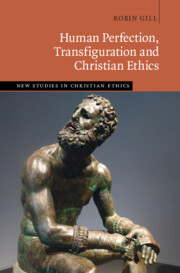Book contents
- Human Perfection, Transfiguration and Christian Ethics
- Reviews
- New Studies in Christian Ethics
- Human Perfection, Transfiguration and Christian Ethics
- Copyright page
- Contents
- Acknowledgements
- Introduction
- Part I Human Perfection
- Chapter 1 Homo Perfectus
- Chapter 2 Glimpses of Artistic Perfection
- Chapter 3 Moral Perfection
- Chapter 4 Perfectionism
- Part II Jesus’ Perfection
- Part III Transfiguration and Global Perfection
- Select Bibliography in Christian Ethics
- Index
- Titles Published in the Series (continued from page )
- References
Chapter 2 - Glimpses of Artistic Perfection
from Part I - Human Perfection
Published online by Cambridge University Press: 09 May 2024
- Human Perfection, Transfiguration and Christian Ethics
- Reviews
- New Studies in Christian Ethics
- Human Perfection, Transfiguration and Christian Ethics
- Copyright page
- Contents
- Acknowledgements
- Introduction
- Part I Human Perfection
- Chapter 1 Homo Perfectus
- Chapter 2 Glimpses of Artistic Perfection
- Chapter 3 Moral Perfection
- Chapter 4 Perfectionism
- Part II Jesus’ Perfection
- Part III Transfiguration and Global Perfection
- Select Bibliography in Christian Ethics
- Index
- Titles Published in the Series (continued from page )
- References
Summary
Chapter 2 notes at the outset that there is a growing interest among biblical scholars in reception history that has spawned considerable theological attention to paintings, music and novels. This chapter is more personal in character, suggesting a number of artistic works where the author could not imagine, at the time, how they could have been done better – the first a complete performance by Yo Yo Ma of Bach’s Cello Suites at the 1995 Edinburgh Festival, the second an astonishing painting, the race-horse Whistlejacket by George Stubbs, featured in London’s National Gallery, and the third an ancient bronze sculpture, The Boxer at Rest, in Italy’s Museo Nazionale Romano. It also looks at a celebrated novel, The Bell, by Iris Murdoch that features a fictional sermon on Matt. 5.48 and raises significant issues about artistic and moral human perfection and the contentious distinction between Murdoch’s novels and her philosophical writings. The chapter also looks at the debates about the theological relevance of the arts variously by David Jasper, Paul Fiddes, David Brown and Jeremy Begbie today, with reference also to Karl Rahner and Paul Tillich of the previous generation.
Keywords
- Type
- Chapter
- Information
- Human Perfection, Transfiguration and Christian Ethics , pp. 35 - 62Publisher: Cambridge University PressPrint publication year: 2024

